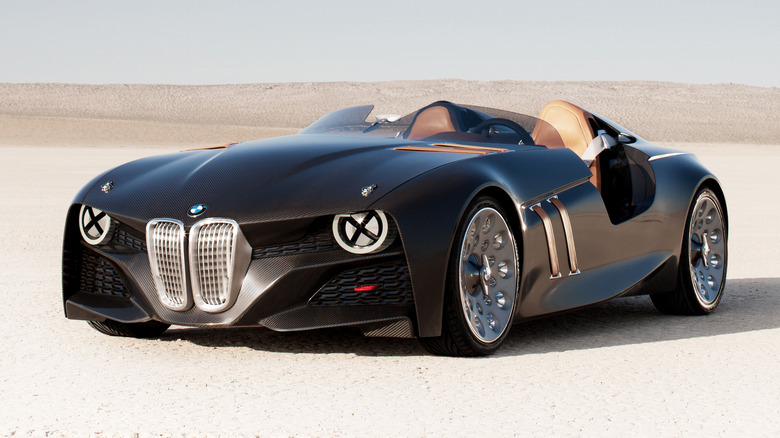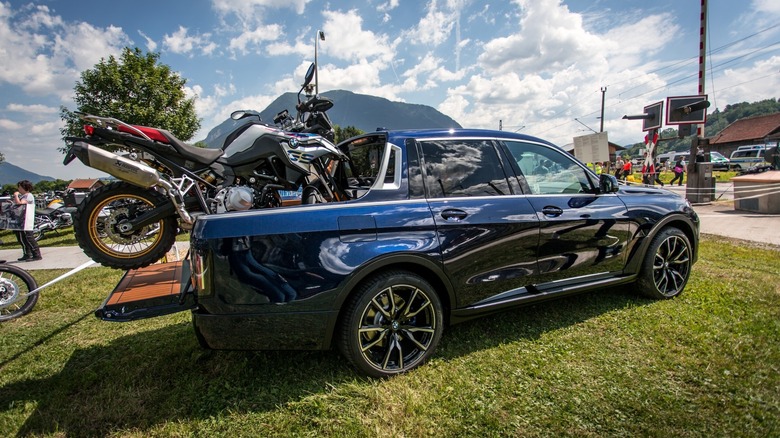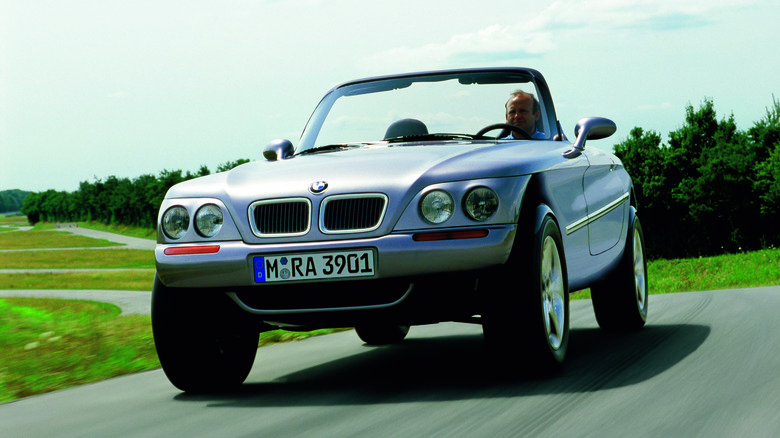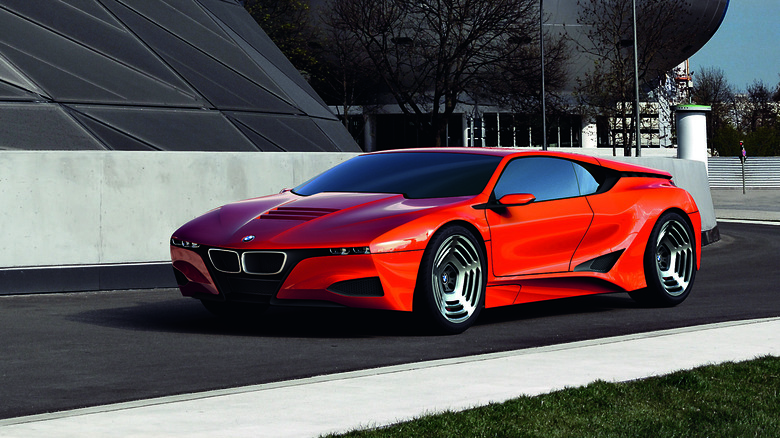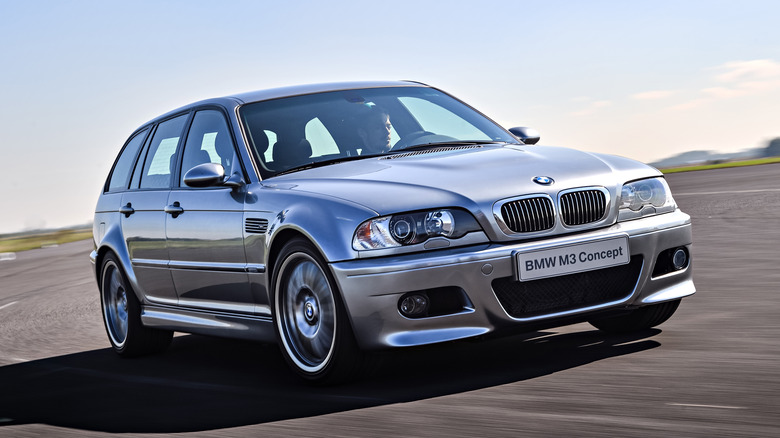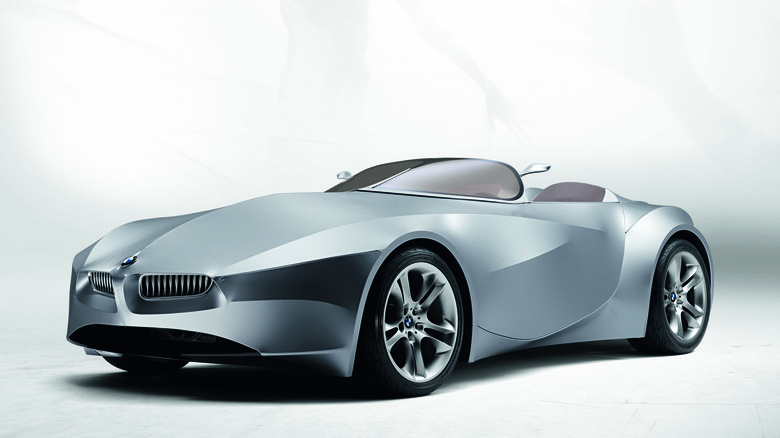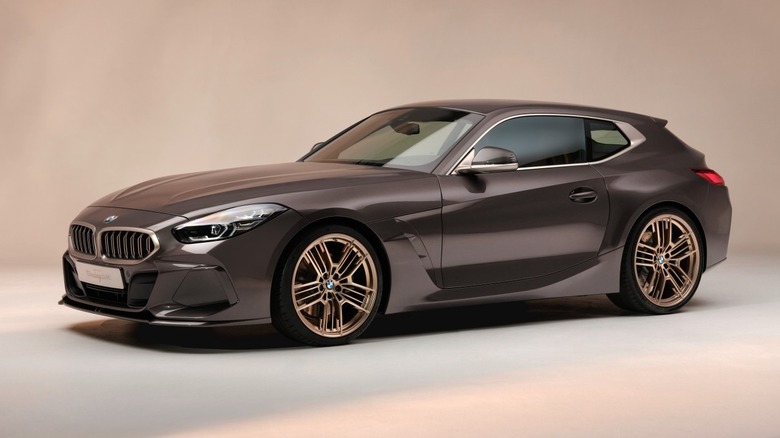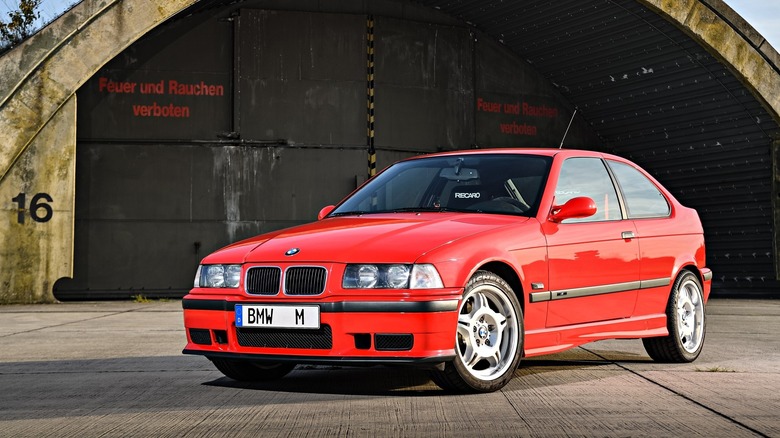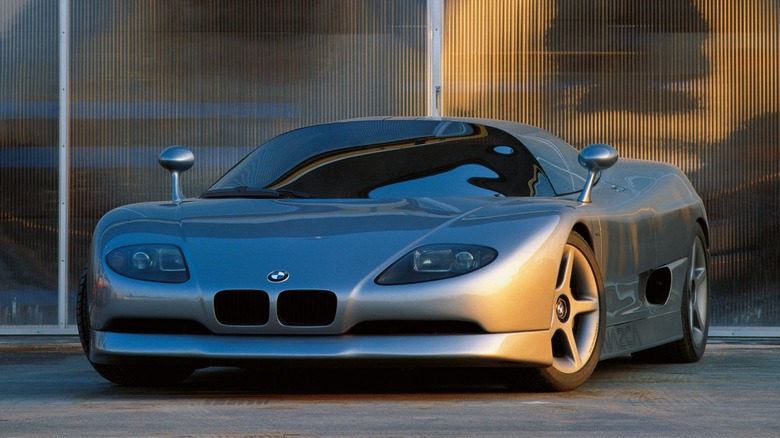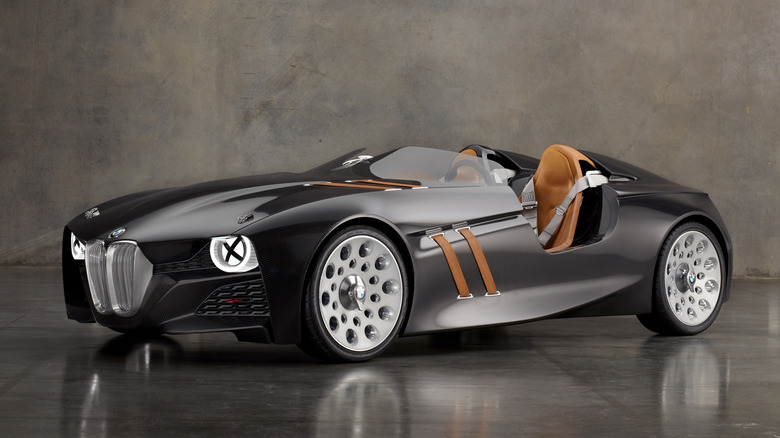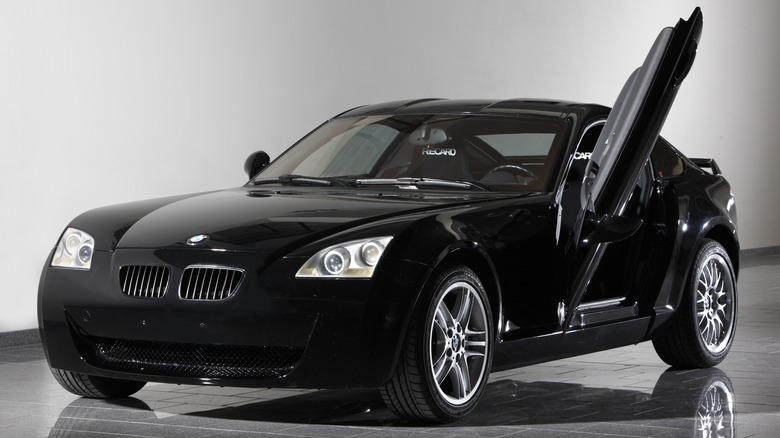12 Fascinating BMW Concept Cars That Never Made It To Production
Not all concept cars are created equal. Some are intended to showcase a manufacturer's new design language, or demonstrate a new way to integrate cutting-edge technology before it reaches mass production. Others are simply the result of designers being given the creative freedom to come up with whatever they want, with the results ranging from genuinely revolutionary to plain bizarre. BMW's back catalog of concept cars contains a mix of all of the above, with the added bonus that many of its concepts and prototypes are functional, often being road legal vehicles rather than rolling mockups.
The Bavarian automaker has a reputation for making concepts that draw a lot of attention then never putting them into production, despite pleas from enthusiasts. However, a few of its concepts are probably better left as one-offs. Many of the concepts here arguably had a chance of success if they were to have reached dealers, but since they're all now consigned to the history books, we'll never know for sure.
BMW X7 Pickup
BMW has never made a production pickup truck, but has developed three different one-off pickups over the years. Two of those were M3-based pickups intended as light-hearted promotional projects, but the third arguably had more production potential. Unveiled in 2019, the BMW X7 Pickup was conceived by students at the brand's training academy. It was built from the chassis of an X7 that had been used for testing and was destined for the scrapyard, with the students given the freedom to transform it how they saw fit.
They designed the pickup as a luxurious motorcycle carrier, with attachment points in the teakwood-clad bed designed to fit the brand's F 850 GS all-terrain motorcycle. It was no simple mock-up either — the pickup was fully road legal and finished to the same quality level as a standard BMW show car.
The pickup was shown off at the brand's Motorrad Days event, but it was never intended to be more than a one-off. The luxury pickup market has expanded significantly in recent years with major players offering buyers ever more luxurious versions of their best-selling trucks, so it's plausible that there might be a market for a pickup from an established luxury brand like BMW. Evidently, however, BMW has no interest in making such a vehicle for now, with the brand insisting at the X7 Pickup's launch that there was never a plan to explore a path to production.
BMW Z18
One of the many BMW oddities that are now mostly forgotten about, the Z18 was a Z roadster but not as most enthusiasts know it. Designed by the BMW Technik skunkworks, the Z18 combined sports car styling with off-road capability to create a car unlike anything else before it. It was, according to BMW, the first off-road roadster ever built. It was also the brand's first 4x4, being unveiled in 1995, around four years before the X5 was launched.
The '90s was a time of wild experimentation by automakers that resulted in some truly bizarre vehicles, but BMW decided that an off-road convertible was simply a step too far. It never reached production, but it did play a role in the development of the production X5. The V8 engine that was originally designed for the Z18 would eventually be used for the X5 lineup. Plus, the expertise gained from designing the Z18's four-wheel drive system would also have come in useful for the production SUV.
BMW M1 Hommage
Built to commemorate the 30th anniversary of the BMW M1, the 2008 M1 Hommage was a modern reinterpretation of the original's classic styling. Its designers took inspiration both from the production M1, penned by Giorgetto Giugiaro, and from the BMW Turbo concept, a predecessor of the M1 penned by Paul Bracq. The M1 Hommage was, in essence, a simple tribute to the '80s supercar, with no production version planned. In fact, the concept wasn't even fitted with an engine.
However, a number of the car's styling features would be used to shape the i8, the production hybrid sports car that served as the M1's indirect successor. The unique Liquid Orange paint of the M1 Hommage didn't make it over to the i8, although a similarly vibrant orange would be available on the BMW 1M Coupe.
As a design study, the M1 Hommage served its role exactly as intended, but there will always be some enthusiasts who wish it was more than that. The i8 might have looked like a supercar, but SlashGear found its 1.5L three-cylinder engine lacking in performance compared to most of its rivals. A production version of the M1 Hommage, in contrast, could have used an existing BMW V8 or V10 from another M model. It could have been a true halo car for the brand, complete with proper supercar performance, but it was not to be. Perhaps that's understandable, given the immense financial pain the development of the original M1 caused the company.
BMW M3 E46 Touring Concept
The first production BMW M3 Touring was unveiled in 2022, combining the power and handling of the standard M3 with the practicality of the wagon body style. Since BMW has already been making an M3 wagon for decades, a common question from enthusiasts is why an M3 wagon didn't appear earlier. The answer is that it nearly did, with engineers proving the idea was viable as far back as 2000.
The issue that bosses had with creating an M3 wagon was that it would potentially require new and costly tools to produce. The 2000 M3 E46 Touring Concept was built to prove that it could be done with existing tools, with the designers managing to skirt around problem areas like the rear doors to create a production-ready design. BMW executives did reportedly mull over the idea of green-lighting the car, but ultimately decided not to for reasons that remain unknown to this day.
While there were inevitably rumors surrounding an E46 M3 wagon, BMW didn't confirm that the car was being evaluated for production at the time. Unlike other M3 variants such as the M3 Compact, the M3 E46 Touring wasn't even given to journalists for testing, being reserved for use by the brand's engineers and executives only. Whether it would have been successful had it made it to production remains impossible to say, but given the success of rivals like the Audi RS6 Avant, there's a good chance it would have found a fanbase.
BMW GINA
Manufacturers love to cloak their concept cars in futuristic materials to showcase their latest and greatest innovations, although most don't go as far as to coat their car in fabric. The BMW GINA, or GINA Light Visionary Model, is one of the few to adopt fabric as a body-shell material, with one continuous piece covering the car. It's no ordinary fabric. It's resistant to water, temperature changes, continuous stretching, and most anything else that regular driving conditions can throw at it.
Since the fabric covers everything, including the doors and the area where the hood should be, BMW had to make a few unusual design decisions. The fabric can be parted in the middle of the car to allow access to the engine, but when it's opened, a metal substructure beneath the car also changes shape to maintain the fabric's surface tension. Likewise, the doors open both upwards and outwards to keep the fabric's tension consistent.
While it's certainly an impressive innovation on paper, how well the fabric would hold up in a real world setting is another question. BMW has never used such fabric in any production car, and since the concept was first unveiled to the public in 2008, it seems unlikely that it will ever be used on a production vehicle. That's probably a good thing — the GINA might have been developed to "challenge conventional and previously pursued solutions," but it's safe to say that most buyers are quite happy with their metal-bodied cars.
BMW Concept Touring Coupé
One of BMW's most recent one-off cars is the Concept Touring Coupé, a hardtop Z4 with shooting brake styling. It's powered by the same inline-6 engine, much like the current Z4, and shares a significant amount of its front fascia. However, the party is in the back: the extended roofline slopes gently down to a small rear hatch, while the side windows gain the brand's signature Hofmeister kink. The car's interior is also uniquely special, featuring a number of high-end touches including plush Italian leather and a custom luggage set developed specifically for the car.
Like many of BMW's most headline-grabbing one-offs, the brand was quick to pour cold water on the idea that the Concept Touring Coupé might pave the way for a production version. According to BMW, the car was only ever intended for one-off production, designed as a statement piece for the 2023 Concorso d'Eleganza Villa d'Este. It's no rolling shell design study though, since it's fully road legal.
Whether the concept influences any future BMW production models remains to be seen, but the car received an almost unanimously positive reception from the press and public. BMW does not offer a shooting brake at all in its current lineup, but it has done so previously, most notably with the "Clown Shoe" Z3M Coupe.
BMW M3 E36 Compact
The 3 Series Compact was the brand's first attempt at making a rival to the VW Golf. It was based on the 3 Series sedan but featured a shorter, more compact appearance, and acted as an entry point to the BMW brand. Most of the examples sold during its decade or so in production were four-cylinder models with modest outputs, but BMW seriously considered giving the car its full M treatment.
Unveiled in 1996, the M3 E36 Compact kept the same shrunken proportions as the mass-produced car but boasted a significantly boosted power output, with 321 horsepower on tap. It was given to select journalists for testing and shown off to the public, but in the end, BMW decided against production. Exactly why isn't known, especially since the car received a positive response from the journalists that initially tested it. The 3 Series Compact would never receive a truly fast model during its lifespan, but its successors, the 1 Series and 2 Series, have both been offered in M-badged configuration.
BMW Nazca M12
For a brand that has arguably only ever produced one true supercar, BMW has made an unusually high number of supercar concepts over the decades. One of the most promising was the Nazca M12. It debuted in 1991 and was followed by two closely related prototypes, the Nazca C2 and C2 Spyder, in 1992 and 1993, respectively. This led to much speculation about an upcoming production model, but ultimately, no series production car was ever announced. However, one particularly influential customer, the Sultan of Brunei, reportedly commissioned an example for his private collection.
The Nazca M12 looked like a spaceship compared to the brand's other production models at the time, with its low-slung, flowing lines reportedly shaped by BMW's racing expertise. Its design also gave it a unique connection to the M1 supercar: the M1 was designed by Giorgetto Giugiaro, while the Nazca M12 was penned by his son Fabrizio. Underneath, the car featured some familiar BMW componentry, most notably its V12 engine, which was borrowed directly from the brand's top-spec production 8 Series.
BMW has never confirmed why the Nazca M12 was never greenlit for production, but it was likely due to financial reasons. The M1 was plagued by development setbacks that pushed it vastly over budget, and it sold in much lower numbers than BMW bosses were expecting. Despite the hype for the Nazca M12, BMW leadership probably decided not to risk another financial disaster, and so the car only ever remained a concept.
BMW Just 4/2
One of the many boundary-pushing vehicles to emerge from BMW's Technik division, the Just 4/2 was designed for simple, straightforward driving fun. It featured a four-cylinder engine making 100 horsepower and virtually nothing in the way of creature comforts — not even a windshield. If that formula sounds familiar, that's because it is. The Caterham Seven has been offering the same open-air thrills for decades, and before that, the Lotus Seven pioneered the design.
Take away the kidney grille and plastic front bumper and the Just 4/2's nose and rounded headlights even look a little like a Caterham. It sounded a little like one too, at least from what can be heard from BMW's grainy archival footage of the car driving around Munich. Like many of the automaker's prototypes, the car was road legal and featured a functional interior, making it a true one-off special rather than a mere design study.
Exactly why the concept failed to progress past the prototype stage isn't known. Perhaps BMW executives couldn't see a large enough market for such a stripped-back car, or perhaps it was deemed too similar to the freshly launched Z3 roadster. Either way, it seems the Just 4/2 was always destined to be consigned to the archives.
BMW 328 Hommage
Much like the M1 Hommage, the 328 Hommage was created to honor a significant anniversary for one of BMW's greatest cars. Except, the 328 is from a very different era — while the M1 Hommage marked the M1's 30th birthday, the 328 Hommage was built for the 328's 75th birthday. The original 328 was a critical car in establishing BMW as a top manufacturer in European motorsports, winning races like the Mille Miglia and, in the process of winning, setting a speed record that still hasn't been beaten today.
The 328 Hommage was a modern reinterpretation of the car built with cutting-edge construction techniques and contemporary power. To keep it as lightweight as the original, BMW made use of carbon fiber-reinforced plastic, alongside aluminum and leather accents for a dash of vintage aesthetic. The car was only ever intended to be a headline-grabbing one-off — a brief it met with aplomb — and so no production version of the car was ever considered.
BMW Z29
One of BMW's most obscure concepts from this century is the Z29. It was unveiled in 2010 alongside a series of other previously unseen concepts to celebrate 25 years of BMW Technik. The concept itself dates back much further, being first built in 2001. It was created by Technik in collaboration with BMW M and featured a carbon fiber reinforced plastic chassis. At the time, such materials were mostly the preserve of Formula 1, and even today CFRP is still rare to find on production cars.
The Z29's engine was borrowed from the M3 of the era, and made around 330 horsepower. With the car being so lightweight thanks to its racing-inspired construction, it was faster than the regular M3, with a 0-62 mph time around the mid-four second mark. That all sounds like a recipe for an excellent production car, but the Z29 was not ever likely to end up in the hands of customers. It was primarily an engineering exercise, one that combined several innovations from two different divisions of BMW into one futuristic car. However, some of the technology developed for the car did reportedly trickle down into following production models.
BMW E1
It's easy to assume that the transition to electric cars is a recent phenomenon, but many automakers have been experimenting with battery power for decades. Some, like BMW, even built practical, usable electric cars, only to shelve further development due to a lack of demand. The E1 was first unveiled at the start of the '90s, reportedly being developed in response to a Californian mandate for zero-emissions vehicles. Select journalists were invited to test drive the car, including Autocar, which boldly claimed the E1 to be "the first fully thought-through and genuinely usable electric car."
The outlet noted that the car was capable of keeping up with traffic around the city, and sported an officially quoted range of more than 150 miles. Its 75 mph top speed meant it was only suited to urban driving, but within the city, it was more quiet and refined than every other car of its size. That all seemed very promising at the time, but thanks to a change in government policy, the E1 never progressed past the prototype stage. California scrapped its zero-emissions mandate in the face of increasing pressure from carmakers, and with no other markets encouraging EV adoption at the time, there was no incentive for the automaker to continue development of the car.
